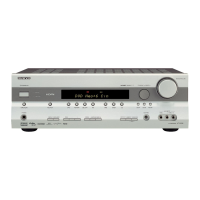47
Using the Listening Modes
—Continued
The following table shows which listening modes can be used with each input signal format.
The AV receiver’s listening modes can transform your listening room into a movie theater or concert hall, with high
fidelity and stunning surround sound.
Pure Audio
In this mode, the display and video circuitry are turned
off, minimizing possible noise sources for the ultimate in
high-fidelity reproduction. (As the video circuitry is
turned off, no video signals are output in this mode.)
Direct
The selected input source is output directly with minimal
processing for a pure sound.
Stereo
The selected input source is processed as a stereo signal
and output by the front left and right speakers and the
subwoofer.
Source format
Listening mode
Analog,
PCM
*1
*1. In the Pure Audio and Direct listening modes, 32 kHz, 44.1 kHz, and 48 kHz PCM is processed at 64 kHz, 88.2 kHz, and 96 kHz respectively. In
listening modes other than Pure Audio, Direct, and Stereo, 64 kHz, 88.2 kHz, and 96 kHz PCM is processed at 32 kHz, 44.1 kHz, and 48 kHz
respectively.
Dolby Digital
DTS/DTS 96/24
*2
*2. In listening modes other than Pure Audio, Direct, Stereo, and DTS 96/24, DTS 96/24 sources are processed as normal DTS.
Multich
analog
3/2.1
2/2.1
2/0 1/0, 1+1 Other
3/2.1
2/2.1
2/0
DTS-ES
Discrete Matrix
CD, TV,
radio,
cassette,
etc.
DVD, DTV, etc. DVD, CD, etc. DVD
Pure Audio
Direct
✔ ✔✔✔✔✔✔ ✔ ✔
Stereo
Mono
✔ ✔✔✔✔✔✔ ✔
Multich
✔
PLII Movie/Music/Game
Neo:6 Cinema
Neo:6 Music
✔✔ ✔
Dolby D
✔✔
DTS, DTS 96/24
✔✔
T- D
✔ ✔✔✔✔✔✔ ✔
Onkyo
Original
DSP
Mono Movie
Orchestra
Unplugged
*3
Studio-Mix
TV Logic
All Ch Stereo
Full Mono
*3. Available only when surround speakers are connected.
✔ ✔✔✔✔✔✔ ✔
Tip: To check the format of the digital input signal, see “Displaying Source Information” on page 39.
About the Listening Modes
The illustration shows which speakers are active in
each listening mode with 5.1 channel speaker sys-
tem.
Front left Center Front right
Subwoofer
Surround rightSurround left
HT-R508En.book Page 47 Wednesday, March 14, 2007 10:12 AM

